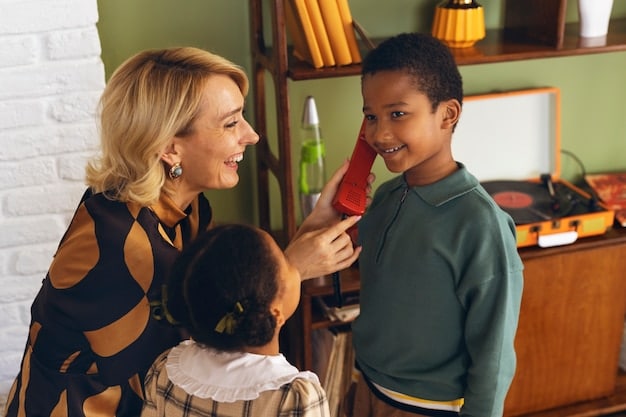Long-Term Effects of Positive Discipline: Raising Resilient Kids

Positive discipline fosters intrinsic motivation and self-regulation in children, cultivating lifelong resilience, strong character, and responsible decision-making abilities that extend far beyond childhood.
In the intricate journey of raising children, parents often grapple with various disciplinary approaches. While traditional methods frequently rely on punishment, a growing body of research and expert opinion points to a more effective, and profoundly impactful, alternative: The Long-Term Effects of Positive Discipline: Raising Resilient and Responsible Children. This philosophy, rooted in respect, understanding, and teaching, aims to guide children toward self-correction and genuine understanding, rather than merely enforced obedience, paving the way for well-adjusted and capable adults.
Understanding the Foundations of Positive Discipline
Positive discipline is not about permissiveness or the absence of rules; rather, it’s a systematic approach grounded in mutual respect and encouragement. It prioritizes teaching life skills and fostering a strong parent-child relationship over punitive measures. This methodology understands that children are learning and developing, and misbehavior often stems from unmet needs or a lack of understanding. Instead of focusing on what a child did wrong, positive discipline helps them learn how to do better in the future.
This approach emphasizes clear, consistent boundaries, coupled with empathy and problem-solving. It involves active listening, validating a child’s feelings, and working together to find solutions. The core belief is that children are more likely to cooperate and internalize lessons when they feel understood, valued, and empowered to contribute. This creates an environment where children feel safe to make mistakes, learn from them, and develop a sense of competence and belonging.
Key Principles Guiding Positive Discipline
Understanding the underlying principles is crucial for successful implementation. These tenets form the bedrock upon which effective interactions and long-term development are built. They guide parents in creating an atmosphere conducive to learning and growth.
- Mutual Respect: Both the child and the parent deserve respect. This means listening to the child’s perspective while firmly and kindly setting limits. It’s about understanding their developmental stage and not expecting more than they are capable of.
- Empathy and Understanding: Acknowledging a child’s feelings, even if their behavior is unacceptable, helps them feel heard and understood. This emotional validation is key to building trust and open communication.
- Problem-Solving and Collaboration: Instead of simply dictating rules, positive discipline involves children in finding solutions to problems. This teaches critical thinking and empowers them to take ownership of their actions.
- Focus on Solutions, Not Punishment: The goal is to teach, not to inflict pain or shame. Consequences should be related, respectful, reasonable, and revealed in advance, helping children learn from their mistakes constructively.
From Short-Term Control to Long-Term Development
Unlike traditional disciplinary methods that often seek immediate behavioral compliance through fear or coercion, positive discipline has its sights set on the future. Its effectiveness isn’t measured by how quickly a child stops a specific unwanted behavior, but by how well they internalize moral reasoning and self-control over time. This foundational shift is what makes it so powerful for long-term outcomes.
The commitment required from parents in adopting positive discipline is significant. It demands patience, consistency, and a willingness to reflect on one’s own reactions and parenting style. This isn’t a quick fix, but rather an ongoing process of learning and adapting, both for the parent and the child. The investment, however, yields profound and lasting rewards, influencing every facet of a child’s personality and their capacity to navigate the complexities of life.
Fostering Emotional Intelligence and Empathy
One of the most significant long-term benefits of positive discipline is its profound impact on a child’s emotional intelligence (EQ) and their capacity for empathy. When parents engage with children in a respectful and understanding manner, they model crucial social and emotional skills. Children learn to identify and express their own emotions constructively and to recognize and respond to the feelings of others. This is a departure from punitive approaches, which can suppress emotional expression or teach children to fear showing vulnerability.
By using calm, clear communication and validating a child’s feelings, parents teach them that all emotions are acceptable, even if certain behaviors are not. This distinction is vital; it allows children to process their inner experiences without shame. Furthermore, involving children in problem-solving helps them consider the impact of their actions on others, directly cultivating empathy. They learn to think beyond their immediate desires and understand different perspectives.
When a child is guided through a difficult situation with empathy, they internalize this approach. They become more adept at regulating their own emotions, leading to fewer explosive outbursts and a greater ability to cope with stress. This emotional resilience is invaluable in navigating friendships, academic challenges, and future professional environments. Children who develop high emotional intelligence are better equipped to form strong bonds, resolve conflicts peacefully, and thrive in complex social settings.
Developing Self-Regulation and Impulse Control
Positive discipline techniques provide children with the tools to manage their own behavior, rather than relying on external controls. Rather than threats or bribes, children learn to understand the “why” behind rules and the natural consequences of their choices. This process actively engages their prefrontal cortex, the part of the brain responsible for executive functions like planning, decision-making, and self-control.
As children repeatedly practice making choices and experiencing reasonable consequences in a supportive environment, their capacity for self-regulation strengthens. They learn to pause before reacting, think through potential outcomes, and choose behaviors that align with their goals and values. This fundamental skill is essential for academic success, healthy relationships, and lifelong well-being. It reduces impulsivity and promotes thoughtful action.
Building Resilience and Adaptability
Life is full of challenges, and resilience—the ability to bounce back from adversity—is a cornerstone of well-being. Positive discipline actively builds resilience by teaching children problem-solving skills and fostering a belief in their own capabilities. When children are allowed to experiment, make mistakes, and then collaboratively find solutions, they develop a sense of agency. They learn that challenges are opportunities for growth, not insurmountable obstacles.
This approach helps children develop a “growth mindset,” where they view failures as learning opportunities rather than evidence of inadequacy. They learn to adapt to new situations, cope with frustration, and persevere in the face of setbacks. Such children are less likely to be overwhelmed by difficulty and more likely to approach unfamiliar situations with curiosity and determination. The adaptive skills they acquire extend far beyond childhood, empowering them to navigate an ever-changing world with confidence.

Cultivating Autonomy and Responsible Decision-Making
Positive discipline operates on the premise that children are capable and should be given opportunities to make choices and experience their natural consequences within safe boundaries. This fosters a sense of autonomy — the feeling that they are in control of their own lives and decisions. Instead of blindly following rules out of fear, children learn to internalize a moral compass and make responsible choices because they understand the reasoning and impact behind them. This is a critical shift from external compliance to internal conviction.
By involving children in setting household rules or discussing solutions to conflicts, parents empower them. This practice helps children develop critical thinking skills, weigh options, and anticipate outcomes. They learn that their voice matters and that their ideas contribute to the family dynamic. This active participation strengthens their sense of responsibility and ownership over their actions.
Developing Intrinsic Motivation vs. External Rewards
Traditional disciplinary methods often rely on external motivators like rewards or punishments to shape behavior. While these can produce immediate results, they tend to foster extrinsic motivation – children act in a certain way to get a reward or avoid a punishment. Positive discipline, however, focuses on nurturing intrinsic motivation, where children are driven by an internal desire to do the right thing because it feels good and aligns with their values.
When children are valued, respected, and encouraged to solve problems, they develop an internal sense of purpose and competence. They learn that contributing positively to their family and community brings genuine satisfaction. This intrinsic drive is far more sustainable and powerful than any external reward. It leads to children who are self-starters, willing to take on challenges, and motivated by a desire for mastery and contribution rather than just tangible incentives.
Strengthening the Parent-Child Bond
Perhaps one of the most profound long-term effects of positive discipline is the strengthening of the parent-child bond. When interactions are characterized by respect, empathy, and collaboration, the relationship becomes a source of security and connection. Children feel safe, loved, and understood, which are fundamental psychological needs. This secure attachment forms the foundation for healthy emotional development and positive relationships throughout life.
Children who experience positive discipline are more likely to communicate openly with their parents, share their challenges, and seek guidance when needed. They view their parents as allies and mentors, rather than as authoritarian figures to be feared or resisted. This strong bond provides a secure base from which children can explore the world, take healthy risks, and develop their independence, knowing they have a supportive foundation to return to.
Furthermore, a strong parent-child bond built on mutual respect and understanding tends to endure into adolescence and adulthood. As children grow older, they are more likely to continue valuing their parents’ advice and company, even as they forge their own paths. This ongoing connection is a testament to the power of consistent positive interactions during formative years, laying the groundwork for a lifelong relationship of trust and affection.
Beyond Childhood: Lifelong Benefits of Positive Discipline
The principles instilled through positive discipline are not confined to the formative years; they extend far beyond childhood, shaping individuals into competent, compassionate, and contributing members of society. The skills of emotional regulation, empathy, problem-solving, and intrinsic motivation become deeply ingrained, serving as fundamental tools for navigating the complexities of adult life, career, and relationships. It is in these long-term ramifications that the true power of this approach becomes evident.
Adults who were raised with positive discipline often demonstrate superior interpersonal skills. They are typically better communicators, capable of resolving conflicts constructively and maintaining healthy relationships. Their developed empathy allows them to understand and appreciate diverse perspectives, making them effective teammates, compassionate partners, and insightful friends. This ability to connect deeply with others is an invaluable asset in both personal and professional spheres.
Impact on Academic and Career Success
The self-discipline, resilience, and problem-solving skills nurtured by positive discipline directly translate into academic and professional success. Children who learn to self-regulate and embrace challenges are more likely to excel in their studies. They develop a strong work ethic, perseverance, and the ability to learn from mistakes—qualities highly valued in any educational or professional setting.
In the workplace, individuals raised with this approach often stand out for their initiative, adaptability, and collaborative spirit. Their intrinsic motivation drives them to pursue excellence, not merely external rewards. They are comfortable with constructive feedback, adept at finding creative solutions, and possess the emotional intelligence to navigate team dynamics and leadership roles effectively. These attributes are increasingly sought after in today’s rapidly evolving global economy.
Contributing to Society and Community
Perhaps the most far-reaching long-term effect is the impact on individuals as citizens and community members. Children who learn respect, responsibility, and empathy are more likely to become engaged, ethical, and compassionate adults. They understand the importance of contributing to the greater good and are inclined to advocate for justice and fairness. This can manifest in various ways, from active participation in local communities to leadership in social causes.
By developing a strong moral compass and a sense of social responsibility, these individuals become valuable assets to their communities. They are guided by principles of cooperation and mutual respect, fostering positive interactions and contributing to a more harmonious society. The ripple effect of raising resilient and responsible children through positive discipline extends beyond individual families, creating a more interconnected and empathetic world for future generations.

Addressing Common Misconceptions and Challenges
Despite its widely recognized benefits, positive discipline is often misunderstood, leading to common misconceptions. One prevalent belief is that it equates to permissiveness or a lack of boundaries. This is unequivocally false. Positive discipline is about setting clear, firm boundaries with kindness and respect. It requires consistency and follow-through, but always with the child’s long-term development in mind, not just immediate compliance. It’s about ‘kind and firm at the same time.’
Another challenge for parents is the perception that positive discipline demands too much time and patience. While it certainly requires more intentional effort than a quick punitive reaction, the investment yields significant returns in the long run. Short-term fixes often lead to recurring problems, whereas teaching life skills through positive discipline prevents future misbehavior and fosters greater independence, ultimately saving time and emotional energy.
Consistency is Key
The success of positive discipline hinges on consistency. Children thrive on predictability and clear expectations. When parents are inconsistent in their responses—sometimes applying principles of positive discipline, other times resorting to traditional punishment—it creates confusion and makes it difficult for children to learn. Consistency means applying methods predictably across different situations and ensuring that both parents, if applicable, are aligned in their approach. This uniformity builds trust and allows children to internalize lessons more effectively.
Moreover, parental self-regulation is crucial. It can be challenging to remain calm and empathetic when a child is testing boundaries or having a meltdown. Practicing self-care and developing strategies for managing parental stress are essential components of consistent positive discipline. Parents are role models, and their ability to regulate their own emotions directly influences a child’s learning.
Adapting to Different Developmental Stages
Positive discipline is not a one-size-fits-all approach; it must be adapted to a child’s developmental stage. What works for a toddler will not be effective for a teenager. For instance, redirecting a toddler might be appropriate, whereas a teenager will benefit more from a collaborative discussion about consequences. Understanding typical developmental milestones helps parents tailor their approach to be age-appropriate and effective.
As children grow, the focus shifts from direct guidance to fostering greater autonomy and more complex problem-solving skills. Parents need to continually adjust their methods, allowing for more independence as children mature, while still providing a supportive framework. This dynamic adaptation ensures that positive discipline remains relevant and impactful through every stage of a child’s journey into adulthood, reinforcing learned behaviors and adapting them to new challenges.
Practical Strategies for Implementing Positive Discipline
Embracing positive discipline requires a shift in mindset and a repertoire of practical strategies that parents can employ daily. It’s about moving from reacting to behaviors to proactively teaching skills and building connection. The goal is to equip children with internal resources, not just external rules. These strategies help create a warm, yet firm, environment where learning and growth are prioritized over immediate obedience.
Parents can begin by focusing on connection before correction. Taking a moment to connect with a child emotionally before addressing a misbehavior often de-escalates tension and opens the door for effective teaching. This might involve a hug, a moment of active listening, or simply acknowledging their feelings. Once the child feels understood, they are more receptive to guidance.
Setting Clear and Consistent Boundaries
Clear, consistent boundaries are the backbone of positive discipline. Children need to know what is expected of them and what the natural or logical consequences of their actions will be. These boundaries should be age-appropriate and communicated kindly but firmly. Involving children in the process of setting rules, where appropriate, can increase their buy-in and sense of responsibility.
For example, instead of saying, “Stop running!” a parent might say, “We walk inside to keep everyone safe. What’s a safer way to move right now?” This rephrases the rule as a positive action and encourages the child to think of solutions. When consequences are necessary, they should be related to the behavior, respectful, reasonable, and revealed in advance, helping the child link their action to its outcome.
Using Encouragement, Not Just Praise
There’s a subtle yet significant difference between praise and encouragement. Praise often focuses on the outcome (“You’re so smart!”), which can lead children to seek external validation. Encouragement, on the other hand, focuses on effort, improvement, and contribution (“I see how hard you worked on that!” or “Thank you for helping clean up, that made a big difference!”).
Encouragement builds self-esteem and fosters an internal locus of control – children learn to value their own effort and progress. It helps them develop a growth mindset, understanding that their abilities can be developed through dedication and hard work. This cultivates intrinsic motivation, leading to children who are resilient, willing to take on new challenges, and driven by a desire for mastery rather than just approval.
Teaching Problem-Solving Skills
One of the most empowering aspects of positive discipline is teaching children how to problem-solve. When conflicts arise or mistakes are made, instead of immediately correcting or punishing, parents can engage children in finding solutions. This might involve asking questions like, “What happened?” “How do you feel about that?” “What do you think we should do to fix this?” and “What can we do differently next time?”
This collaborative approach equips children with valuable life skills. They learn to identify problems, brainstorm solutions, evaluate potential outcomes, and take responsibility for their choices. This process not only resolves the immediate issue but also prepares them to navigate future challenges independently and thoughtfully. By empowering them to find their own solutions, parents foster competence and confidence that extends far beyond the specific situation.
| Key Aspect | Brief Description |
|---|---|
| 💖 Emotional Growth | Fosters empathy, self-regulation, and strong interpersonal skills. |
| 🌱 Resilience Building | Teaches problem-solving and adaptability through mistakes. |
| 💡 Autonomy & Responsibility | Cultivates independent, responsible decision-making from within. |
| 🤝 Stronger Bonds | Enhances parent-child connection through mutual respect and trust. |
Frequently Asked Questions About Positive Discipline
Positive discipline is a parenting philosophy focused on teaching life skills and fostering a strong parent-child relationship. It emphasizes mutual respect, problem-solving, and understanding a child’s behavior, aiming to guide children toward self-correction and responsible decision-making rather than relying on punishment or external controls.
Positive discipline is distinct from permissive parenting. While both avoid harsh punishment, positive discipline involves setting clear, consistent boundaries and firm expectations with kindness and respect. Permissive parenting lacks boundaries and firm guidance, often leading to children struggling with self-control, whereas positive discipline teaches self-regulation and responsibility.
The long-term benefits include increased emotional intelligence, empathy, self-regulation, and resilience in children. They develop stronger problem-solving skills, intrinsic motivation, and autonomy. These traits contribute to academic and career success, healthier relationships, and a greater capacity to contribute positively to society as adults.
Yes, positive discipline principles can be adapted for all ages, from toddlers to teenagers. The core concepts of respect, understanding, and teaching remain consistent, but the specific strategies and level of involvement in problem-solving evolve with a child’s developmental stage. Consistency and tailored approaches are key to its effectiveness across different age groups.
Implementing positive discipline requires patience and consistency. It’s a long-term approach, and results may not be immediate. Continued application, understanding the child’s perspective, focusing on connection, and adapting strategies are crucial. Seek resources or professional guidance if challenges persist, as positive discipline is a learned skill for both parents and children.
Conclusion
The journey of raising children is undeniably complex, yet the enduring evidence unequivocally points towards the profound, transformative power of positive discipline. This isn’t merely a set of techniques for managing behavior; it’s a holistic philosophy that nurtures the whole child, fostering emotional intelligence, resilience, and a deep-seated sense of responsibility. By prioritizing respect, empathy, and collaborative problem-solving over punitive measures, parents lay a robust foundation for their children’s future, equipping them with the intrinsic motivation and life skills necessary to thrive as confident, capable, and compassionate adults. The long-term investments in positive discipline yield returns that extend far beyond the family unit, contributing to a more harmonious and understanding society, one well-adjusted individual at a time.





